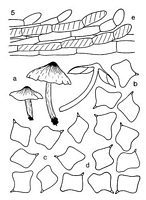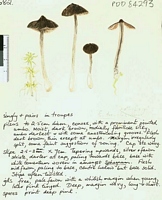|
 Entoloma nothofagi Entoloma nothofagi
SynonymsEntoloma staurosporum
Entoloma botanicum
Entoloma conferendum
BiostatusPresent in region - Indigenous. Endemic
Images (click to enlarge)
Caption: Entoloma nothofagi Stev. (holotype):
b. spores. (Herb. Hk. 69/130): a. carpophores. c. spores e. cuticle. (holotype
of Entoloma botanicum Stev.): d. spores. | 
Caption: Watercolour
Owner: G.M. Taylor |
Article: Horak, E. (1971). A contribution towards the revision of the Agaricales (Fungi) from New Zealand. New Zealand Journal of Botany 9(3): 403-462 (http://www.rsnz.org/publish/abstracts.php).
Notes: Entoloma botanicum Stevenson (27 D) = Entoloma nothofagi Stevenson (see
there)
Article: Horak, E. (1973). Fungi Agaricini Novazelandiae I-V. Beihefte zur Nova Hedwigia 43: 200 p.
Description: Pileus
20-40 mm diam., conical or broadly convex-umbonate, margin incurved, conspicuously
fibrillose, aged carpophores wrinkled or grooved (at least at the centre), dry,
margin not striate, deep brown or fuscous. Lamellae adnexed or free, brownish
when young, becoming deep pink-brown, gill edge concolorous, moderately crowded.
Stipe 30-50 x 3-5 mm, cylindrical or attenuated upwards, dry, greybrown, densely
covered by brownish fibrils, white (from mycelium) at the base, fragile, hollow,
sometimes twisted. Context brownish. Odor and taste farinaceous or like cucumber.
Spores
10-12 x 9-11.5 µm, quadrate or rhomboid, with pronounced edges. Basidia 30-40
x 10-12 µm, 4-spored. Cheilo- and pleurocystidia none. Cuticle a cutis of repent
or suberect, cylindrical hyphae (8-18 µm diam.), membrane thin-walled, not gelatinized,
with brown plasmatic or vacuolar pigment. Clamp connections absent.
Habitat: On
soil under Nothofagus spp., rarely under Dacrydium-podocarpus.
New Zealand.
Notes: The
deep brown pileus (covered by conspicuous wrinkles), the free lamellae and the
rhomboid spores characterize E. nothofagi. The species grows not only
under Nothofagus spp. but also in broad-leaved- and podocarpus-forests
miles from the nearest stand of Nothofagus (Stewart Island).
According
to its macro- and microscopical characters (see also original descriptions)
E. botanicum Stev. has to be regarded as a synonym of E. nothofagi.
In the field E. nothofagi can readily be confused with E. procerum
Stev. but the latter species has large cheilocystidia and cuboid-tetrahedral
spores.
|